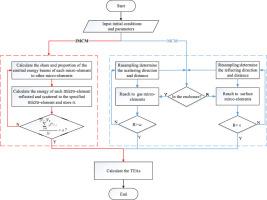Journal of Quantitative Spectroscopy and Radiative Transfer ( IF 2.3 ) Pub Date : 2020-05-20 , DOI: 10.1016/j.jqsrt.2020.107081 Guo-Jun Li , Jia-Qi Zhong , Xiao-Dong Wang

|
An improved Monte Carlo method (IMCM) is developed in this paper to solve the total radiant exchange areas (TEAs), which can greatly improve calculation accuracy and save CPU time. This approach, features two main improvements on the basis of the Monte Carlo method (MCM). First, the location of the surface emission points and the number of emission energy beams are subdivided, thereby improving the calculation accuracy. Specifically, it is assumed that the energy beams emitted by one micro-element are emitted from M points on average. Second, the energy beams emitted by the surface and gas micro-elements are only arranged once, and the sampling of surface reflection is eliminated, thereby improving the calculation efficiency. Specifically, the ratio of the energy beams emitted by one micro-element directly to other micro-elements can be calculated. The reflection and scattering energy of one micro-element to other micro-elements are obtained by iterative accumulation. This approach can greatly save CPU time compared with sampling the reflected and scattered energy beams. The application of IMCM to a two-dimensional (2D) square cavity is considered in this study. The effects of surface emissivity and boundary temperature on radiative heat transfer are analyzed. IMCM was used to solve the TEAs, and the calculated results of IMCM, MCM and the pathlength method (PLMCM) were compared based on the results of the reduced integration scheme (RIS). The all results show that the IMCM is more accurate than the MCM and PLMCM and is more efficient than the MCM and PLMCM for calculating the TEAs.
中文翻译:

参与介质中辐射传热的改进蒙特卡罗方法
为了解决总辐射交换面积(TEA)问题,本文提出了一种改进的蒙特卡洛方法(IMCM),可以大大提高计算精度,节省CPU时间。这种方法在蒙特卡洛方法(MCM)的基础上进行了两项主要改进。首先,将表面发射点的位置和发射能量束的数量细分,从而提高了计算精度。具体而言,假设由一个微元素发射的能量束是从M发射的。平均得分。其次,由表面和气体微元素发射的能量束仅布置一次,并且消除了表面反射的采样,从而提高了计算效率。具体而言,可以计算出一个微量元素直接发射的能量束与其他微量元素的比率。一个微元素对其他微元素的反射和散射能量是通过迭代累积获得的。与采样反射和散射的能量束相比,此方法可以大大节省CPU时间。本研究考虑了IMCM在二维(2D)方腔中的应用。分析了表面发射率和边界温度对辐射传热的影响。IMCM用于求解TEA,IMCM的计算结果,基于简化积分方案(RIS)的结果,比较了MCM和路径长度方法(PLMCM)。所有结果表明,IMCM比MCM和PLMCM更准确,并且比MCM和PLMCM更有效地计算TEA。











































 京公网安备 11010802027423号
京公网安备 11010802027423号